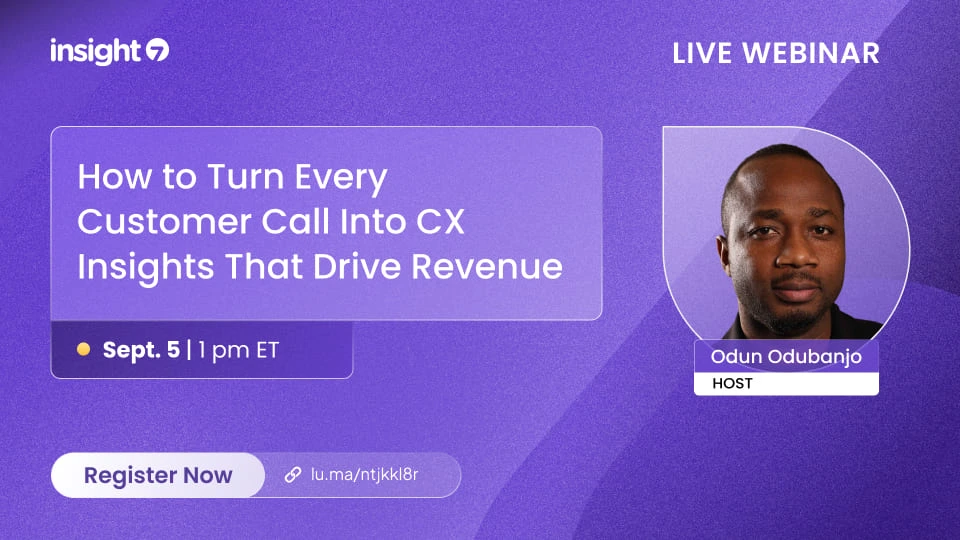Speech Analytics Customer Engagement: Practical Tips
-
Bella Williams
- 10 min read
Understanding the power of customer communication requires keen attention to the nuances of interaction. Engaging effectively with customers not only enhances their experience but can also drive loyalty and satisfaction. In the realm of speech analytics, understanding engagement analytics tips is crucial for refining these interactions. By leveraging data-driven insights, organizations can unlock the potential of valuable customer conversations and insights to optimize their communication strategies.
To truly boost customer communication, businesses must focus on analyzing the intricate details within customer interactions. This involves identifying key themes and understanding customer sentiments. Implementing engagement analytics tips can transform how organizations respond to customer needs, allowing for more personalized and impactful interactions. Embracing these practices is more than just a trend; it is an essential move towards fostering deeper relationships with customers.
Generate visualizations from your qualitative data. At Scale.

Understanding the Value of Speech Analytics in Customer Engagement
Speech analytics enables organizations to tap into the vast insights embedded in customer interactions. Understanding its value in customer engagement can noticeably enhance communication strategies. By analyzing conversations, businesses can detect patterns and address customer needs more effectively. This process not only reveals what customers value but also helps identify areas for improvement.
In practice, employing engagement analytics tips can transform raw conversation data into actionable insights. For instance, analyzing customer call trends illuminates common concerns and frequent questions. Additionally, using sentiment analysis tools can cultivate a deeper understanding of customer emotions, allowing for tailored responses. By consistently monitoring key performance indicators, organizations can evaluate the effectiveness of their strategies and adapt accordingly. Ultimately, the power of speech analytics lies in its ability to foster meaningful connections with customers, driving loyalty and satisfaction.
Engagement Analytics Tips: Identifying Key Customer Interaction Points
Identifying key customer interaction points is essential for optimizing engagement and improving overall customer experience. By analyzing call trends, organizations can unveil vital insights about customer behavior. Start by examining monthly call data to discern patterns across various interactions. This method allows you to identify recurring themes such as common questions or frequent concerns mentioned by customers.
Next, pinpointing the most prominent issues faced by customers can significantly enhance service delivery. Use analytics to extract and summarize pain points consistently mentioned in conversations. By approaching engagement analytics in this systematic way, you establish a clearer understanding of customer needs. This not only informs your team but also equips them to address concerns more effectively. Ultimately, these engagement analytics tips aim to create a more responsive and informed customer engagement strategy, allowing businesses to foster stronger relationships with their clients.
- Step 1: Analyze Customer Call Trends
To begin analyzing customer call trends, it's essential to transcribe recordings accurately. This transcription process serves as the foundation for extracting valuable insights from customer conversations. By transcribing calls, you can create a library of interactions that allows for easy analysis. With the right tools, bulk transcription of multiple files can streamline this process, making it efficient and effective.
Once transcribed, focus on identifying patterns in the conversations. Look for recurring themes or pain points that customers frequently express. Analyzing calls in this way can reveal critical insights into customer behavior and preferences. By utilizing insights from these trends, businesses can better tailor their communication strategies to enhance customer engagement. Gathering this data helps pinpoint areas for improvement, ultimately leading to a more responsive and customer-focused approach. Understanding call trends not only boosts engagement analytics but also lays the groundwork for ongoing relationship building with your customers.
- Step 2: Pinpoint Common Customer Concerns
In this step, focus on identifying the common concerns customers express during their interactions. By analyzing these concerns, businesses can gain valuable insights into the customer experience. Begin by reviewing past conversations to highlight recurring themes, such as product functionality, pricing issues, or service expectations. Understanding these patterns enhances customer satisfaction and informs staff training, ensuring representatives address specific concerns effectively.
Next, categorize these concerns to identify priority areas for improvement. For example, if many customers express confusion about product features, this could indicate a need for clearer communication or enhanced product training for your team. By pinpointing and addressing these common concerns, businesses not only improve customer interactions but also build trust and loyalty. Ultimately, thoroughly understanding customer pain points enables more meaningful engagements, transforming a transactional relationship into a consultative partnership.
Engagement Analytics Tips: Enhancing Customer Experience with Data
Enhancing Customer Experience with Data is vital in today’s competitive landscape. By implementing effective engagement analytics tips, businesses can gain remarkable insights into customer behaviors and sentiments. One foundational approach is utilizing sentiment analysis tools. These tools sift through customer interactions to reveal positive or negative feelings, allowing you to adjust your strategies in real time. Tailoring responses based on historical data further enhances this process, ensuring that your team addresses customer concerns effectively and personally.
Additionally, it’s essential to analyze patterns within customer interactions. This can include identifying peak call times or frequently mentioned issues. Such insights enable proactive adjustments to service and product offerings. By actively engaging in these steps, organizations can create a more responsive customer experience. Every data point becomes a valuable opportunity to enhance overall satisfaction and loyalty, fostering deeper connections with clients.
- Step 1: Utilize Sentiment Analysis Tools
To enhance customer engagement through speech analytics, start by utilizing sentiment analysis tools. These tools can effectively gauge the emotional tone of customer interactions. Knowing whether a sentiment is positive, negative, or neutral allows you to identify areas that are excelling or need attention. Regularly monitoring the tone of customer calls equips your team with insights that directly inform engagement strategies.
Consider the insights from customer calls where emotions are quantified—like happy, frustrated, or confused tones. This data can identify trends, helping you understand prevalent customer sentiments. For example, recognizing a spike in negative feedback regarding a specific product feature allows you to address it proactively. Ultimately, leveraging sentiment analysis facilitates more personalized interactions with customers, fostering stronger relationships and improving overall satisfaction. To dive deeper into the integration aspects, explore various best practices that fit your customer engagement framework.
- Step 2: Tailor Responses Based on Historical Data
Understanding historical data is critical for tailoring effective responses in customer engagement. By analyzing past interactions, businesses can uncover valuable insights into common customer concerns and preferences. This understanding enables customer service representatives to address queries more precisely and empathetically, thereby enhancing overall satisfaction.
Utilizing historical data, organizations can create targeted responses that resonate better with customers. This approach not only streamlines communication but also fosters a sense of understanding and connection. For instance, if certain issues frequently arise in past calls, representatives can prepare specific solutions to address these proactively. Additionally, aggregating past customer sentiments allows teams to craft responses that more closely align with customer emotions, promoting a more engaging interaction. Overall, harnessing historical data effectively transforms customer engagement into a more personalized and meaningful experience.
Evaluate Performance on Customer Calls for Quality Assurance.
Implementing Engagement Analytics Tips for Maximum Impact
Implementing Engagement Analytics Tips for Maximum Impact requires thoughtful integration of speech analytics tools into customer engagement strategies. Start by selecting the right software that fits your organization’s unique needs and goals. The chosen tool should provide features like sentiment analysis and data visualization, enabling you to distill insights from extensive customer interactions.
Equally important is training your team on effective use of these tools. Conduct workshops and provide resources that empower staff to analyze and interpret the collected data effectively. This will help enhance both customer communication and overall service quality. Regularly consider collecting feedback to assess how these tools impact customer satisfaction. With consistent monitoring, you can refine your approach, optimizing interactions based on real-time analytics. Ultimately, these engagement analytics tips form a foundation to transform your customer engagement strategy into a more impactful experience.
Steps for Integrating Speech Analytics Tools
Integrating speech analytics tools begins with selecting the appropriate software for your organization. This choice should align with your specific needs and objectives. Look for platforms that offer user-friendly interfaces, enabling broader team access without requiring extensive training. Once you've selected software, the next critical step is to ensure that your team is adequately trained in utilizing these tools. Comprehensive training sessions will help maximize the value derived from the analytics.
Additionally, set up a structured process for collecting and analyzing speech data. Collect data consistently to identify trends and derive insights, while creating mechanisms for the team to act on these insights. By establishing clear protocols, you facilitate better communication and responsiveness to customer needs. These steps together form a powerful framework for integrating speech analytics tools, ultimately refining customer engagement and driving success.
- Step 1: Choose the Right Speech Analytics Software
Choosing the right speech analytics software is a foundational step in enhancing customer engagement. First, it is essential to consider your specific needs and goals. This includes assessing the features that can automate call transcription, provide analytics dashboards, and offer sentiment analysis tools to understand your customers better. Ensuring that the software aligns with your existing platforms can streamline the integration and maximize its effectiveness.
Next, evaluating different software options can lead you to the solution that fits your unique environment. Look for user-friendly interfaces and robust support options. Request demos and explore case studies to grasp how other organizations have successfully utilized the software. Finally, an emphasis on data security and compliance is vital, especially if you handle sensitive customer information. By making informed choices in your software selection, you set a solid foundation for capitalizing on engagement analytics tips and enhancing overall customer satisfaction.
- Step 2: Train Your Team for Effective Use
To ensure your team can effectively utilize speech analytics tools, thorough training is essential. Start by clearly outlining the objectives of using engagement analytics. Make sure your team understands how these tools can improve customer interactions and enhance service quality. Engaging storytelling techniques during training will help emphasize their purpose and foster team member buy-in.
Next, consider designing interactive training sessions that allow team members to practice using the tools in real scenarios. Encourage them to share insights and experiences, which will create a collaborative learning environment. Reinforce the importance of analyzing customer feedback to identify trends, concerns, and preferences. This way, your team will not only become proficient in using the tools but also be able to utilize them to drive meaningful improvements in customer engagement. With proper training, your team can harness engagement analytics tips effectively, ultimately leading to higher satisfaction levels and better customer relationships.
Engagement Analytics Tips: Measuring Success and Making Improvements
To effectively measure success and make improvements in customer engagement, it's essential to utilize targeted Engagement Analytics Tips. Begin by monitoring key performance indicators (KPIs) that align with your engagement strategies. These metrics provide valuable insights into customer behavior, allowing you to assess areas that are performing well or require adjustments. Regularly review these metrics to identify trends over time, ensuring you can respond proactively to shifts in customer sentiment.
Next, iterate on feedback and outcomes to foster continuous improvement. Gathering customer feedback is crucial for understanding their experiences and expectations. Utilize this information to refine your approach and make informed decisions about enhancements. By regularly analyzing engagement data alongside customer feedback, you can develop a more dynamic strategy that not only measures success but actively drives improvements in customer interactions. This ongoing process will help in creating a more engaging customer experience.
- Step 1: Monitor Key Performance Indicators (KPIs)
Monitoring Key Performance Indicators (KPIs) is crucial for understanding and improving customer engagement. By tracking these metrics, you gain valuable insights into communication effectiveness and customer satisfaction. Begin by selecting key indicators relevant to your business goals, such as customer retention rates, average response times, and the frequency of successful resolutions. These metrics will serve as a foundation for analyzing and enhancing team performance.
Engagement analytics tips suggest conducting regular reviews to assess trends over time. Set specific targets for each KPI and evaluate your progress periodically. This process not only helps identify areas needing improvement but also highlights successful strategies. Utilize qualitative feedback gathered from customer interactions to complement your quantitative data. Regularly adjusting your approach based on these insights ensures that your customer engagement strategies remain aligned with evolving needs. Keep your team informed of these findings to foster a culture of continuous improvement.
- Step 2: Iterate on Feedback and Outcomes
To successfully iterate on feedback and outcomes, it’s essential to create a structured approach that relies on customer insights. Begin by assessing the feedback gathered from customer interactions. Analyze key performance indicators (KPIs) related to engagement metrics to identify patterns and areas for improvement. This process should involve collecting data from customer surveys, call recordings, and chat logs to drive targeted adjustments in your approach.
Next, implement changes based on the identified issues and monitor how these modifications impact customer engagement. This might include enhancing training for customer service representatives or tweaking scripted responses to better address common concerns. Consistently reviewing these outcomes ensures you stay aligned with customer needs, allowing for a dynamic strategy that evolves with customer expectations. Fostering an environment where feedback is valued and used constructively ultimately leads to a more responsive and effective engagement strategy.
Conclusion: Mastering Engagement Analytics Tips for Ongoing Success
In conclusion, mastering engagement analytics tips is essential for continuous improvement in customer interactions. By systematically analyzing speech patterns, businesses can uncover valuable insights that highlight customer pain points and preferences. Implementing these tips enables organizations to refine their strategies, ensuring they remain responsive to customer needs and expectations.
Ongoing success in engagement analytics relies on a commitment to data-driven decision-making. As companies invest time in understanding their analytics, they enhance their customer experiences and drive better outcomes. Ultimately, adopting these practices not only strengthens relationships but also positions organizations for sustained growth in an ever-evolving market.







